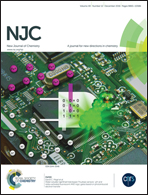Halide ion-driven self-assembly of Zn(ii) compounds derived from an asymmetrical hydrazone building block: a combined experimental and theoretical study†
Abstract
Three Zn(II) complexes, namely mononuclear derivatives [Zn(H2L)2I2]·2CH3OH (1) and [Zn(H2L)2Br2]·2CH3OH (2) and a tetranuclear cyclic compound [Zn4(H2L)4Cl8]·4CH3OH (3) {H2L = p-hydroxybenzaldehyde isonicotinoylhydrazone}, were synthesized using a self-assembly method and fully characterized. Characterization included theoretical methods and single crystal X-ray diffraction. The molecular structures of compounds 1–3 demonstrate the effect of halide ions and the binding mode of H2L on self-assembly. The arrangement of the packing patterns in 1–3 is well explained by various types of non-covalent interactions. Notably, several types of strong H-bonding, C–H⋯O, and π⋯π interactions were also observed, which assist in the formation of 3D supramolecular networks. In the isostructural compounds 1 and 2, a tripod type H-bonding interaction of H2L with the methanol molecules of crystallization was observed. Furthermore, the terminal halide ligands exert H-bonding interactions with the –OH/–NH and –CH moieties of H2L. In all compounds, the supramolecular 3D networks, driven by strong H-bonding interactions, were simplified by topologial analysis. This showed a 6-connected framework with a unique topology in 1 and 2, and an 8-connected framework with bcu topology in 3 (the latter is composed of cyclic tetrazinc(II) cluster units with 2M4-1 topology). In addition, the discussion on coordination geometries and non-covalent interactions was also supported using Hirshfeld surface analysis and DFT calculations.



 Please wait while we load your content...
Please wait while we load your content...